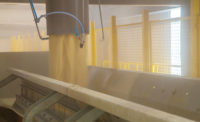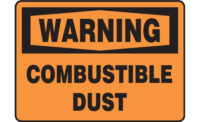NFPA 652 2016 Edition– Fundamentals of combustible dusts
Scope
National Fire Protection Association® Standard 652 provides the basic principles of and requirements for identifying and managing the fire and explosion hazards of combustible dusts and particulate solids. Thanks to Guy Colonna, NFPA Division Director, for supplying information for this profile.
The standard applies to facilities and operations manufacturing, processing, blending, conveying, repackaging, generating, or handling combustible dusts or combustible particulate solids. It does not apply to storage or use of consumer quantities; storage or use of commercially-packaged materials at retail facilities; display of materials in original packaging in mercantile occupancies; warehousing of sealed containers; and storage or use of materials used in farm buildings.
A “Combustible Particulate Solid” is defined as any solid material composed of distinct particles or pieces, regardless of size, shape, or chemical composition, when processed, stored, or handled in the facility has the potential to produce a combustible dust.
Why this standard is important
The U.S. Chemical Safety Board has long asserted that chemical dust explosions are a "serious industrial safety problem." CSB research reveals that nearly 200 dust fires and explosions have occurred in U.S. industrial facilities over the past 25 years, resulting in approximately 100 fatalities and 600 injuries.
In 2017, OSHA proposed nearly nearly $2 million in fines against a Wisconsin corn milling facility after five employees were killed and 12 others injured in a grain dust explosion. OSHA found accumulations of highly combustible grain dust throughout the facility.
Key requirements
Too many to list in detail here. Purchase NFPA 652 at www.nfpa.org. NFPA 652 contains general requirements and specific requirements for Hazard Identification; Performance-Based Design Option; Dust Hazards Analysis; Hazard Management Mitigation and Prevention; Management Systems.
A facility owner/operator with potentially combustible dust must determine combustibility and potential explosiveness; identify and assess any fire, flash fire, and explosion hazards; manage the identified hazards; and communicate information about the hazards.
Testing includes screening for combustibility or potential explosiveness and making a determination of combustibility or explosive potential by either: historical facility data or published data deemed to be representative of current materials and process conditions; analysis of representative samples. The absence of prior incidents is not to be used as basis for deeming a particulate to not be combustible or explosive.
Hazard Management covers mitigation and prevention and includes building design; equipment design; housekeeping; ignition source control; personal protective equipment; dust control; explosion prevention/protection; and fire protection.
Management Systems cover operating procedures and practices; inspection, testing, and maintenance; training and hazard awareness; contractors; emergency planning and response; incident investigation; management of change; document retention; and management systems review.
Keywords
Dust Hazards Analysis: A systematic review to identify and evaluate the potential fire, flash fire, or explosion hazards associated with the presence of one or more combustible particulate solids in a process or facility. Goals of a hazard analysis include identifying the hazards inherent with an activity; identifying process upsets, human errors, equipment failures leading to undesired consequence (injuries, equipment damage, environmental damage, etc.); identifying and evaluating existing protections; and determining whether additional protections are necessary, and propose such protections
Common DHA techniques include Hazard and Operability Analysis (HAZOP); Checklist Analysis; What If Analysis; What If/Checklist Analysis; Failure Modes and Effects Analysis (FMEA); and Layers of Protection Analysis (LOPA).
DHA methodology involves identifying and evaluating where fire, deflagration, or explosion hazard exists; identifying and evaluating specific fire and deflagration scenarios; identifying safe operating ranges; identifying safeguards in place; and recommending additional safeguards where warranted and develop plan for implementation.
DHA definitions:
Process systems – each part of the process system where combustible dust is present or combustible particulate solids could cause combustible dust to be present shall be evaluated.
Building or building compartments – each building or building compartment where combustible dust is present shall be evaluated. Where similar buildings or building compartments present essentially the same hazard, a single evaluation is permitted.
Sponsor: (800) VAC-U-MAX www.vac-u-max.com/vacuum



